Introduction to Palenta
In the vast world of delightful and diverse dishes, palenta indeed holds a unique place. Initially, let’s embark on a comprehensive journey to explore the various facets of it, a dish that transcends borders and cultures. Furthermore, it offers a warm, comforting presence on dining tables around the globe. Not only is it a versatile and hearty meal, but it also boasts a rich history and a variety of preparation methods. Additionally, it’s a dish that can be enjoyed in numerous forms, from soft and creamy to grilled or fried, each offering a unique texture and flavor profile. Moreover, the dish is not just limited to main courses; it can also be a delightful ingredient in desserts, showcasing its incredible versatility. So, as we delve deeper into the world of palenta, prepare to uncover its secrets, tips for perfect preparation, and much more.
What is Palenta Made of?
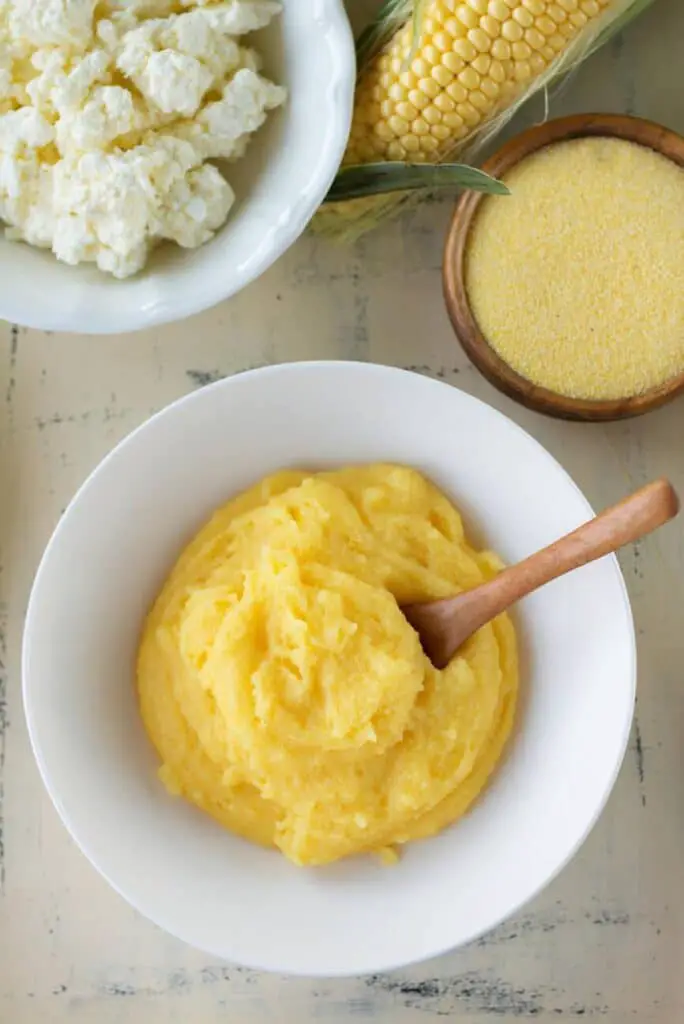
it is a simple yet delightful dish, and its basic ingredients reflect that simplicity. At its core, this dish is made from cornmeal, water, and a pinch of salt. The cornmeal used is typically yellow, finely ground, and made from dried corn. The process of making the recipe involves boiling water and slowly adding the cornmeal while stirring continuously to prevent lumps from forming. As the mixture cooks, it thickens into a creamy, porridge-like consistency.
The beauty of this dish lies in its versatility. While the basic recipe involves just three ingredients, you can enhance the flavor by substituting water with broth or adding other ingredients like cheese, butter, herbs, or spices. This flexibility allows you to tailor the dish to your specific taste preferences, making this dish is a favorite for many who enjoy experimenting in the kitchen.
In essence, while the dish is made of simple, humble ingredients, it provides a canvas for culinary creativity, allowing you to create a dish that is not only satisfying and delicious but also uniquely your own.
How to Cook Palenta?
Cooking the recipe is a straightforward process, but it does require patience and attention to detail. Below is a basic guide to help you create a perfect, creamy recipe:
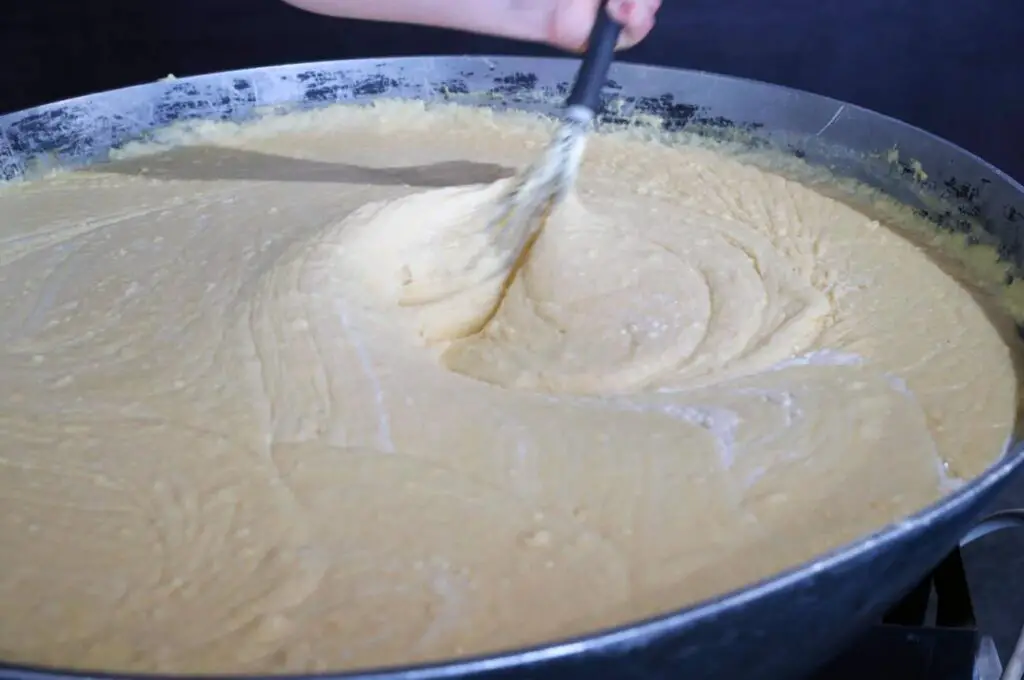
Ingredients:
- Cornmeal
- Water or Broth
- Salt
- Optional: Butter, Cheese, Herbs, or Spices
Instructions:
- Measure the Ingredients: Start by measuring the cornmeal and liquid. The typical ratio is 1 part cornmeal to 4 parts liquid, but you can adjust this based on your desired consistency.
- Boil the Liquid: Bring the water or broth to a boil in a heavy-bottomed saucepan. Add salt to taste.
- Add the Cornmeal: Gradually whisk in the cornmeal to prevent clumping. Pour it in a steady stream while continuously stirring.
- Reduce Heat and Simmer: Lower the heat to a simmer and continue to stir the mixture. This process will take about 20-30 minutes. Ensure you stir frequently to prevent the palenta from sticking to the bottom of the pan.
- Check the Consistency: As it cooks, it will thicken. If it becomes too thick, you can add a bit more liquid to reach your preferred consistency.
- Add Additional Ingredients: Once the palenta is cooked to your liking, stir in additional ingredients like butter, cheese, herbs, or spices for extra flavor.
- Taste and Adjust: Give the recipe a taste and adjust the seasoning as needed. Add more salt, pepper, or other seasonings to enhance the flavor.
- Serve: Serve the palenta hot as a creamy side dish, or pour it into a tray and let it cool and solidify to be grilled or fried later.
Tips for Perfect Palenta Recipe:
- Use a whisk to add the cornmeal to ensure a lump-free texture.
- Opt for a heavy-bottomed saucepan to evenly distribute the heat.
- Keep the heat low to prevent it from burning.
- Be patient and stir frequently for the best results.
Nutritional Benefits of Palenta
Embarking on the journey of exploring palenta, it’s crucial to shed light on its nutritional benefits. Not only does palenta stand out as a delicious dish, but it also packs a punch when it comes to nutrition. Firstly, it serves as a fantastic source of carbohydrates, providing the energy you need to get through the day. Additionally, it is low in fat and calories, making it a suitable choice for those aiming to maintain a healthy diet.
Moreover, palenta is naturally gluten-free, offering a wholesome and hearty meal option for individuals with gluten intolerance or celiac disease. Besides these benefits, palenta is rich in essential vitamins and minerals, including vitamin A, vitamin C, and some B vitamins. It also contains important minerals like iron, magnesium, and phosphorus, contributing to overall health and well-being.
Furthermore, the versatility of palenta allows for the incorporation of various other nutritious ingredients. You can enhance its nutritional profile by adding vegetables, lean proteins, or healthy fats, creating a balanced and nutrient-rich meal. In essence, it is not just a feast for the taste buds; it’s also a boon for your health, offering a range of nutrients that support overall well-being.
Different Varieties of Palenta
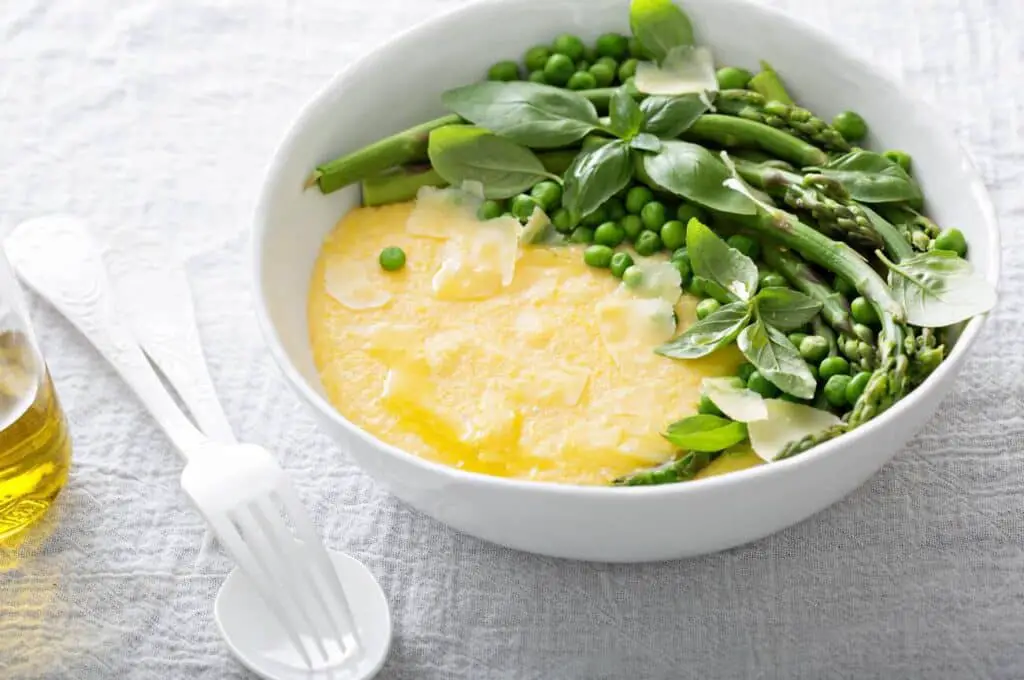
When it comes to palenta, the variety is indeed the spice of life. The dish’s versatility allows it to take on many forms, each offering a unique culinary experience. Let’s delve into the different varieties of the recipe that you can explore and enjoy.
1. Creamy Palenta:
This version is the most common, where the cornmeal is cooked to a soft, porridge-like consistency. It’s perfect as a side dish or a base for sauces, meats, and vegetables.
2. Grilled or Fried Palenta:
After cooking palenta to a creamy consistency, you can let it set, cut it into pieces, and then grill or fry it. This method gives palenta a crispy exterior while maintaining a soft interior, adding a delightful texture contrast to your meals.
3. Baked Palenta:
Baking it is another fantastic option. You can mix in various ingredients like cheese, herbs, and spices, and bake it until it’s golden and crispy. Baked palenta makes for a delicious and hearty meal that’s sure to satisfy.
4. Palenta Cakes:
it can also be used to make savory cakes. Combine it with your favorite ingredients, shape it into cakes, and cook until they’re beautifully golden. Palenta cakes are a unique and tasty dish that’s perfect for any occasion.
5. Dessert Palenta:
Yes, palenta can even be a dessert! Cook it with milk, sugar, and other sweet ingredients to create a delightful dessert that’s a perfect end to any meal.
6. Palenta with Add-Ins:
Enhance the flavor and texture of the recipe by adding ingredients like cheese, fresh herbs, roasted vegetables, or cooked meats. These add-ins transform the basic palenta into a gourmet dish.
Palenta vs. Polenta: What’s the Difference?
Origin and Name:
Firstly, the terms “palenta” and “polenta” originate from different regions and languages. While both dishes have similar preparations and ingredients, the names represent regional linguistic variations. Moreover, some regions use the term palenta, while others prefer polenta.
Ingredients:
Additionally, the ingredients used in palenta and polenta can slightly differ. Generally, both dishes primarily use cornmeal, water, and salt. However, specific regional recipes might incorporate unique ingredients, offering a distinct flavor and texture to the dish.
Cooking Techniques:
Furthermore, the cooking techniques for palenta and polenta can also vary. Both dishes require the cornmeal to be stirred into boiling water or broth, cooked until they reach a creamy consistency. Nevertheless, some traditional recipes might employ particular cooking methods, enhancing the dish’s authenticity and flavor.
Serving Style:
Another aspect to consider is the serving style. Both palenta and polenta can be enjoyed in various forms – creamy, grilled, baked, or fried. Yet, the presentation and accompaniments might differ, reflecting the culinary traditions of the region.
Flavor Profile:
Lastly, the flavor profile of the recipe and polenta can have subtle differences. While the basic taste remains similar, regional variations and additional ingredients can impart a unique flavor to each dish, making each experience distinct and enjoyable.
Vegan and Gluten-Free Palenta Recipes
In the diverse world of culinary arts, it stands out as a dish that can effortlessly adapt to various dietary preferences, including vegan and gluten-free diets. Below is a guide to preparing a basic vegan and gluten-free palenta, along with a few ideas to enhance and diversify the dish to suit your taste buds.
Basic Vegan and Gluten-Free Palenta:
Ingredients:
- Cornmeal
- Water or Vegetable Broth
- Salt
- Optional: Olive Oil or Vegan Butter
Instructions:
- Boil the Liquid: Bring water or vegetable broth to a boil in a saucepan.
- Add Cornmeal: Gradually add cornmeal while continuously stirring to avoid lumps.
- Cook: Reduce the heat and let it simmer, stirring frequently until the mixture thickens and the cornmeal is cooked through.
- Season: Add salt to taste, and optionally, a bit of olive oil or vegan butter for richness.
Enhancing Your Palenta:
1. Herb-Infused Palenta:
Add fresh herbs like rosemary, thyme, or basil to the cooking liquid to infuse the palenta with aromatic flavors.
2. Palenta with Roasted Vegetables:
Top your cooked palenta with a medley of roasted vegetables for a colorful, nutritious, and satisfying meal.
3. Palenta and Mushroom Ragout:
Prepare a rich mushroom ragout and serve it over creamy palenta for a hearty and flavorful dish.
4. Grilled Palenta with Vegan Pesto:
Allow the palenta to cool and solidify, cut into pieces, and grill. Serve with a dollop of homemade vegan pesto for a fresh and herby touch.
5. Dessert Palenta:
Cook palenta with almond milk and sweeten with maple syrup or agave nectar. Top with fresh berries and a drizzle of vegan chocolate sauce for a sweet treat.
Pairing Palenta with Other Foods
1. Palenta and Roasted Vegetables:
Initially, consider pairing creamy palenta with a colorful array of roasted vegetables like bell peppers, zucchini, and cherry tomatoes. The roasted vegetables not only add a sweet, caramelized flavor but also introduce a delightful crunch, complementing the soft and creamy palenta beautifully.
2. Palenta with Mushroom Sauce:
Additionally, you can top your palenta with a rich and hearty mushroom sauce. The earthy flavors of mushrooms paired with the smooth palenta create a comforting and satisfying meal, perfect for cozy dinners.
3. Palenta and Grilled Meat:
Furthermore, for meat enthusiasts, it pairs beautifully with various grilled meats. Serve it alongside grilled chicken, steak, or sausages for a robust and hearty meal. The smoky flavors from the grill contrast wonderfully with the mild recipe, offering a multi-layered taste experience.
4. Palenta and Seafood:
Moreover, elevate your dish by topping it with sautéed shrimp, scallops, or other seafood. The delicate seafood flavors and palenta’s creaminess make for an elegant and delicious pairing, ideal for special occasions.
5. Palenta and Fresh Herbs:
Also, enhance your recipe with the addition of fresh herbs like basil, parsley, or chives. The herbs add a burst of freshness and vibrant color, making the dish not only tastier but also more visually appealing.
6. Palenta and Cheese:
Alternatively, add grated Parmesan, Gorgonzola, or any cheese of your choice to your dish. The cheese melts into the warm dish, adding a rich and indulgent flavor, perfect for cheese lovers.
7. Palenta and Spicy Tomato Sauce:
For those who prefer a bit of a kick, serve your dish with a spicy tomato sauce. The sauce’s tanginess and heat add excitement and depth to the recipe, ensuring a flavorful and zesty meal.
8. Palenta and Vegan Options:
Lastly, for a vegan pairing, top your recipe with sautéed greens, beans, or a vegan ragout. These options provide a wholesome and plant-based meal without compromising on flavor, ensuring inclusivity in the delightful world of palenta pairings.
FAQs
What is polenta made of?
Polenta is made of ground yellow corn that’s been boiled in water or broth. It’s commonly eaten as a hot porridge or cooled and solidified into a loaf that can be baked, fried, or grilled.
What Kind of Food is Polenta?
Polenta represents a traditional Italian dish prepared from ground yellow cornmeal. It’s typically cooked with water or broth until it reaches a porridge-like consistency. It can be served as is, or allowed to set and then be baked, fried, or grilled. Polenta is a versatile dish, often used as a base for other ingredients like sauces, vegetables, and meats.
Is polenta just corn flour?
Manufacturers make polenta from cornmeal, which has a coarser texture than corn flour. While producers grind corn flour very finely, the cornmeal for polenta typically has a more granular texture.
Is Polenta and Grits the Same Thing?
Polenta and grits are not the same, although they are similar. Both use stone-ground cornmeal and undergo similar preparation methods, but they originate from different types of corn. Polenta is crafted from ground yellow corn, while grits are derived from white corn, also known as hominy. The flavor and texture of the two dishes are distinct, with polenta having a more robust flavor and grits being finer and softer in texture.
What is the meaning of the word palenta?
The word “palenta” is likely a misspelling of “polenta.” There isn’t a separate definition for “palenta” in English; it usually refers to polenta itself.
Are polenta and grits the same thing?
Polenta and grits are not the same, although they are similar. Both are made from ground corn, but polenta is derived from ground yellow corn, whereas grits are typically crafted from white corn (hominy). The corn for grits also undergoes treatment with an alkali in a process known as nixtamalization.
Is polenta just corn flour?
Polenta is not just corn flour. It’s made from cornmeal, which is coarser than corn flour. Polenta refers to both the raw material (cornmeal) and the finished dish, which is a staple of Italian cuisine. Corn flour is finely ground and is used differently in cooking and baking.
Related Posts:
- Pizza Hawaiana: Tropical Flavors Meet Classic Italian Tradition
- Twin Cities Live Recipes: Delicious Dishes For Every Occasion
- Sopa de Mariscos: A Delicious Seafood Soup Recipe Explained
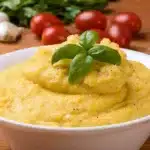
Palenta: Your Ultimate Recipe to Cooking and Enjoying Palenta
- Total Time: 45 minutes
- Yield: 4 servings
- Diet: Vegetarian
Description
Savor the simplicity and comfort of homemade polenta, a staple of Italian cuisine with a creamy texture and rich corn flavor. This polenta recipe is a delightful base for a variety of toppings, from savory cheeses to hearty stews, and can be enjoyed as a cozy side dish or a main attraction.
Ingredients
- 4 cups water
- 1 cup coarse-ground cornmeal
- 1 teaspoon salt
- 2 tablespoons unsalted butter (optional)
- 1/4 cup grated Parmesan cheese (optional)
Instructions
- Bring water to a boil in a large saucepan. Add salt.
- Gradually whisk in the cornmeal to prevent any lumps from forming.
- Reduce the heat to low and cook, stirring frequently, until the mixture thickens and the cornmeal is tender, about 30 to 40 minutes.
- Remove from heat and optionally stir in butter and Parmesan cheese until well combined.
- Serve warm as a creamy base for your favorite dishes, or spread onto a flat surface to cool and solidify for grilling or frying.
Notes
For a richer flavor, you can replace half of the water with milk or add herbs and spices.
Leftover polenta can be stored in the refrigerator and reheated, or sliced and grilled for a crispy texture.
- Prep Time: 5 minutes
- Cook Time: 40 minutes
- Category: Side Dish
- Method: Stovetop
- Cuisine: Italian
Nutrition
- Serving Size: 1 cup
- Calories: Approximately 150 (without butter or cheese)
- Sugar: 0.6g
- Sodium: 590mg
- Fat: 1.5g (without additional butter or cheese)
- Saturated Fat: 0.5g (without additional butter or cheese)
- Unsaturated Fat: 0.5g (without additional butter or cheese)
- Trans Fat: 0g
- Carbohydrates: 31g
- Fiber: 2.7g
- Protein: 3.4g
- Cholesterol: 0mg (without additional butter or cheese)

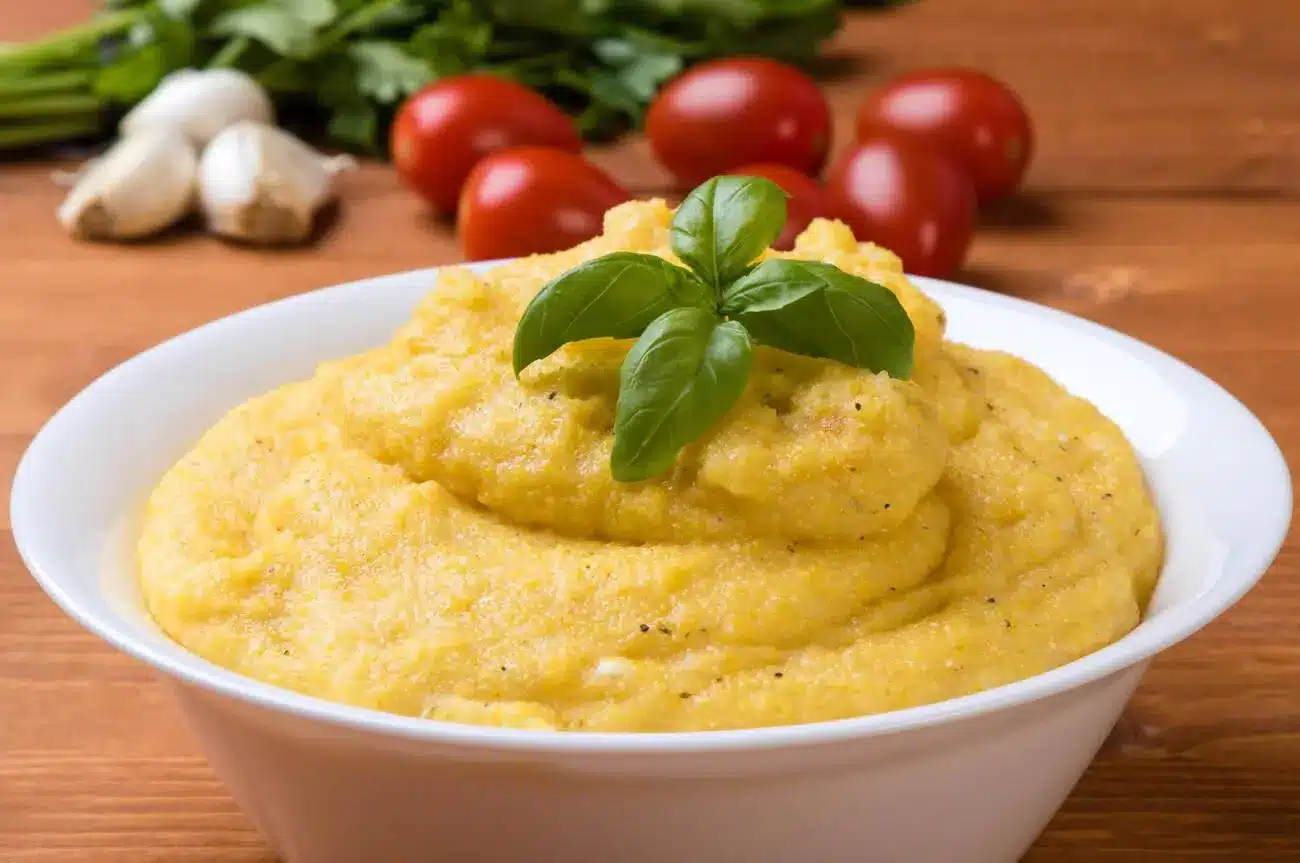



[…] Grits, however, come from white corn. Interestingly, there’s an article on the website about palenta, which seems to be a typo but might provide insights into this cornmeal […]
[…] why not explore more of Mexican cuisine? Dive into a hearty Sopa de Mariscos or try your hand at Palenta, another corn-based delight. And if you’re in the mood for something meaty, Carne Con Papas […]
[…] better than a Grimace Shake? A Grimace Shake with a side of Palenta or Carne Con Papas. The creamy texture of the shake complements the savory flavors of these dishes, […]
[…] on its own, exploring other dishes can enhance your culinary journey. For instance, learning about Palenta can introduce you to new textures and […]
[…] For instance, have you ever tried adding it to a sopa de mariscos or using it as a base for a palenta […]